
Chalmette Battlefield recalls War of 1812
CHALMETTE, La. — Nestled on the banks of the beautiful Mississippi River, just six miles east of downtown New Orleans, rests a quaint open meadow. It is bordered by the pleasant Rodriguez Canal to the west, a small grove of trees to the north and the river bank to the south.
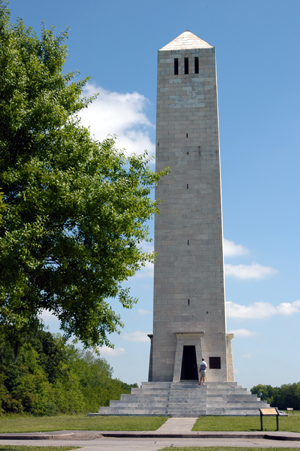 |
| Battle of New Orleans Memorial (Staff photos). |
As couples enjoy their picnics and families bike through the meadow it is easy to forget that this land once played host to the deadly final battle in the War of 1812.
The Chalmette Battlefield saw its glory during the final month of 1814 and the opening days of 1815 when Andrew Jackson built a defensive barricade out of the western bank of the Rodriguez Canal and used it to defeat the British in one of the best strategic moves of the entire war.
The Chalmette Battlefield is now part of the Jean Lafitte National Historical Park, which is based in New Orleans.
The battlefield and adjacent Chalmette National Cemetery constitute one of six sites in Louisiana that form the Lafitte Historical Park.
At that the end of 1814, a British cavalry of 10,000 men led by Maj. Gen. Sir Edward M. Pakenham were headed for New Orleans in an attempt to take over the city and take control of its port.
The British rightfully saw New Orleans as the most strategically sound southern city to capture because of its positioning on the Mississippi and its close proximity to the Gulf of Mexico.
“The Mississippi is the reason the British were here,” said Chalmette Battlefield Park Ranger C.J Longaneckar.
“To control the Mississippi was to control 41percent of the U.S. shipping. If they would have captured New Orleans we would have lost the Louisiana Purchase and the west probably would have been Canadian.”
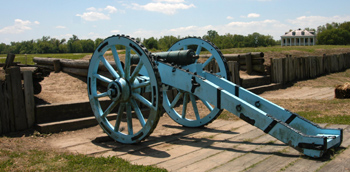 |
| A cannon on display. |
As the British began their march between the northern bank of the Mississippi and the southern edge of the Cypress Swamp, they chose to camp roughly nine miles east of New Orleans at the Villere Plantation.
While they were camped Andrew Jackson unexpectedly attacked with 1,200 American men and then quickly retreated three miles to the Rodriguez Canal, which was on the north side of the river running perpendicular to the Mississippi River and the Cypress Swamp.
“The sneak attack in late December was crucial to knock the British back on their heels before they marched into New Orleans,” said David Moore, professor of history at Loyola University in New Orleans.
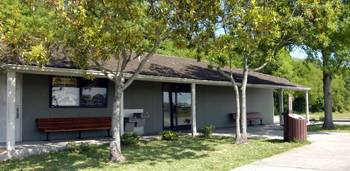 |
| The Visitor Center offers exhibits, souvenirs, and a short film. |
Knowing that the British would have to cross the canal if they wanted to get any closer to New Orleans, Jackson built up a dirt barricade using the western bank of the canal as a shield.
In addition, he widened the canal in an attempt to make it harder to cross and called in eight thousands more troops to help defend New Orleans.
“This was the best place for the battle to happen from an American point of view because it was a narrow strip of land that Jackson’s troops could defend much more easily,” said Ranger C.J Longanecker. “The addition of the wall that they built behind the (Rodriguez) canal only made it easier for the U.S.”
As Maj. Gen. Sir Edward M. Pakenham and his men marched through the La Ronde Plantation and onto the Chalmette Plantation on January 8, 1815 they were fired upon unmercifully by Andrew Jackson and his army of militia members, volunteer troops and trained military fighters. Using the barricade that they had built behind the Rodriguez Canal as protection, the U.S. fighters could pick off the British military and then return to cover behind their barricade.
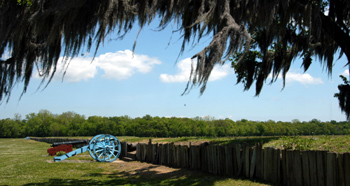 |
Spanish moss hangs from trees near the American line of defense during the Battle of New Orleans. |
“The canal was important because time was important,” said Moore. “Once they reinforced the western side it gave them the jump that they needed for victory.”
The creative use of the Rodriguez canal led to the death of 2,000 British soldiers against a mere 13 U.S casualties. In less than two hours the battle was finished when Major General Pakenham was shot and killed and his troops retreated to nearby Lake Borgne. This victory for the U.S. not only ended the Battle of New Orleans but also ended the War of 1812.
“This battle was so important to world history because it is this victory that changed world power from the hands of the British to the hands of the Americans,” said Ranger C.J Longanecker.
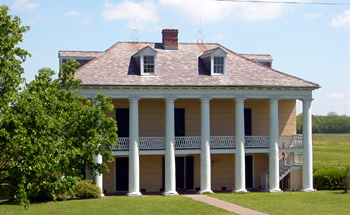 |
| The Beauregard House (Photo by Julie Major). |
Today, the Chalmette Monument stands near the Rodriguez Canal as a tower of more than 70 feet that commemorates the battle fought and the lives lost in the Chalmette Plantation.
Although the monument broke ground in 1840 with the help of a former president and war hero Andrew Jackson, it was not completed until 1908 due to insufficient funds.
Sitting at the opposite end of the battlefield is the Chalmette National Cemetery which has lain to rest over 15,000 soldiers spanning every American conflict. The cemetery was established in 1864 as a burial ground for Union soldiers who died in Louisiana during the Civil War.
Although the cemetery is positioned directly to the west of the Chalmette Battlefield, it holds only four soldiers who fought in the War of 1812 and only one soldier who fought for Andrew Jackson at the Chalmette Battlefield.
Butting up against the banks of the Mississippi River on the south side of the battlefield stands the Malus-Beauregard House, which is a three-story estate that was built 18 years after the Battle of New Orleans concluded.
The house was home to a number of wealthy southerners during the 1800s and was named for Judge Rene Beauregard, who was the last private owner of the home. The house was never associated with the plantation but adds an element of southern culture to the battlefield with its long white columns and French-Louisiana architecture.
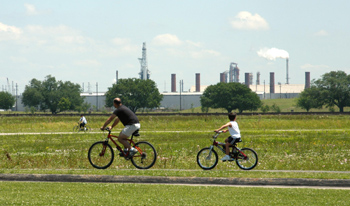 |
| Bicyclists find the quiet park and its 1.5-mile road inviting. |
Scattered throughout the park are a number of park benches and picnic tables to accompany the 1.5-mile road that leads the visitor on a walking tour of the battlefield.
With plenty of shade and the peacefulness of a country park, it is easy to see why locals like to use this park as an escape from the nearby city.
“It is just a nice day away from the telephones and the TV,” said Violette, Louisiana resident Patricia Demary who was having a picnic with her husband in the park. “We are not city people so we really like to come here and relax.”
While local residents don’t always take the walking tours and listen to the stories when they visit the park, the rich history of American pride and courage under fire will never be forgotten.
“There is a lot of history here,” said Patricia’s husband, Bobby Demary. “If this field could talk it would have a lot of stories to tell. So would all of the boys who died here defending our country.”
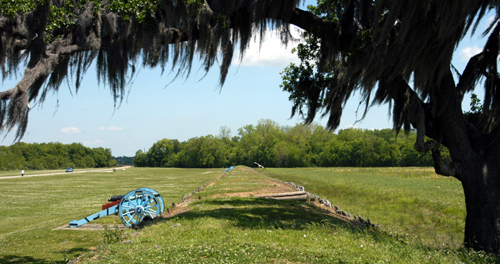 |
| The American cannon placements and barricade along the canal. |

Comments are Closed